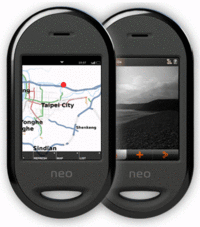Neo FreeRunner
From Openmoko
| Languages: |
English • العربية • Български • Česky • Dansk • Deutsch • Esperanto • Eesti • Español • فارسی • Suomi • Français • עברית • Magyar • Italiano • 한국어 • Nederlands • Norsk (bokmål) • Polski • Português • Română • Русский • Svenska • Slovenčina • Українська • 中文(中国大陆) • 中文(台灣) • Euskara • Català |
Neo FreeRunner
The Neo FreeRunner is the second phone designed to run Openmoko software and is the direct descendant of the earlier Neo 1973.
Contents |
Specifications
- High resolution touch screen 2.84” (43mm x 58mm) 480x640 pixels
- 128MB SDRAM memory
- 256 MB integrated flash memory (expandable with microSD or microSDHC card)
- microSD slot supporting up to 16GB SDHC (Secure Digital High Capacity) cards (Supported microSD cards)
- Internal GPS module
- Bluetooth
- 802.11 b/g WiFi
- 400Mhz ARM processor
- 2 3D accelerometers
- 2 LEDs illuminating the two buttons on the rim of the case (one bicolor [blue|orange] behind the power button, 1 unicolor [red] behind the aux button)
- Tri-band GSM and GPRS
- USB Host function with 500mA power, allowing you to power USB devices for short periods (will drain the FreeRunner battery faster)
Versions: The Neo FreeRunner is available in two versions, one for the GSM bands of North America (850/1800/1900 Mhz), and one for the GSM bands in the rest of the world (900/1800/1900 Mhz). Unless you explicitly discuss this, a local reseller may by default send you the version appropriate to the distributors location.
A full list of the hardware specs and components of the Neo FreeRunner can be found at Neo FreeRunner Hardware.
A comparison between Neo 1973 and Neo FreeRunner is available at Neo 1973 vs Neo FreeRunner.
Getting the Neo FreeRunner
The FreeRunner can be purchased from a distributor. The software available on the phone makes it suitable for power users and developers only -- it is not yet ready for the general consumer. Email announcements are found on the announce mailing list. research papers For frequently asked questions please check FAQ.
Intended use and users
The Neo FreeRunner is a Linux-based touch screen smart phone ultimately aimed at general consumer use as well as Linux desktop users and software developers.
Linux users and software developers will appreciate the total freedom they have to use and design software for the FreeRunner.
General phone users will eventually appreciate the high spec and performance of the phone and the wide range of free software packages expected to emerge. These will allow users to make the maximum use of the hardware and tailor it to their particular needs. Since launch, the pace of software tweaks and improvements has increased as both the Openmoko team developers and the wider community work together.
How usable is it?
With most distributions the FreeRunner is working as a reliable phone. However it still has usability issues and many advanced features are still missing. (For example with SHR, the most used distribution, the phone keeps ringing for a second after a call has been accepted) For more information see distributions.
Please see the FreeRunner: Selected Blogs and Articles to get more reviews. The Neo FreeRunner Hardware Issues page may also be of interest.

